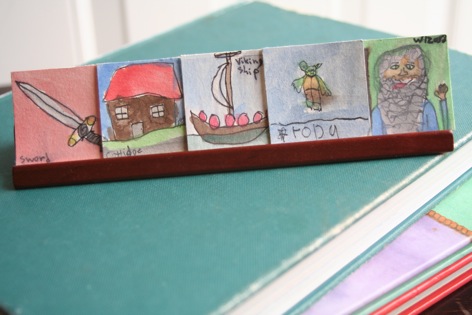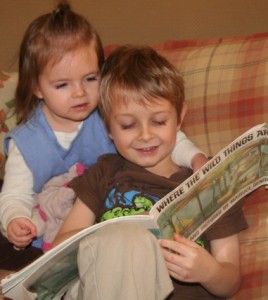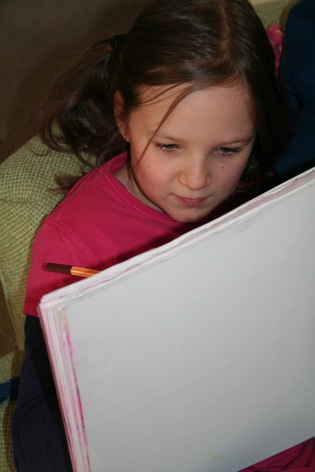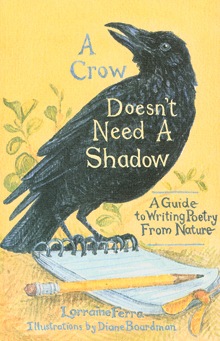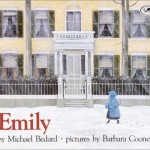Story Squares: A Project with Possibilities
The day of the birthday party arrived and two anxious girls asked me, “Did you find the woooden blocks so we can make our gift?”
“No I didn’t, but I have another idea.”
Disappointed that they couldn’t duplicate the story blocks that we’d made last year for our writing prompts, they took a little while to warm to my idea.
But eventually it caught on and they headed off to the party with a unique gift.
A few days later they followed it up with a similar, but customized, gift for their Dad.
We decided to call the gift Story Squares:
Using my paper cutter, I cut 1.5 inch squares from one full sheet of watercolor paper.
With a sharpie they drew characters, props, and places.
Then they watercolored the pictures.
With the fine point sharpie, they added a one or two word description on their picture in small print. Â (If you have young ones helping you with the project, you can do the labeling to help clarify the picture for others.)
After decorating a recycled box with a title,
we put these these directions inside:
Story Game: The first participant takes a square (without looking to see what it is). He/she begins the story, including the character, prop, or setting from their square in the story. The story continues through the circle of players, each participant using the picture they draw to carry the story along. Used squares remain in a pile and participants take fresh squares to continue another round.
Story Prompts for Writing: Draw three or more cards and begin writing a story, don’t stop for correct grammar or to get the right word, just write!
At the birthday party, the newly turned 12 year old opened the Story Squares first. Â Then she opened all of her other gifts and when she was finally done she picked up the Story Squares and said, “Can we try these?”.
So we had the chance to see our idea played out with a very large circle of girls. This kept them entertained for about thirty minutes, with several rounds as they mixed the cards and began again. Â One aspect that makes this fun is to have elements and characters that wouldn’t normally be found in a story together. There were some very funny moments when snow men popped up in castles or trolls ended up on a viking ship.The only rule I would add for next time is to include at least four to five sentences per turn in order to challenge your players past a dry and less imaginative, “And then the knight came”.
For their Dad’s birthday we brought our squares to our favorite pancake house and dove into stories of Yoda, Vikings, and Wizards (I said it was customized for their Dad right!)
Today the girls used the story squares for their friday freewrite and I’ll share a bit of that with you next time.
My ideas are brewing with variations on the Story Squares:
- Substitute a line of dialogue  instead of  a picture for some of the squares.
- Play the story game “Fortunately, Unfortunately” with the squares. Â An example: The first person draws a princess and says, “Fortunately, the princess was the most beautiful girl in the kingdom”. Â The next person draws an invisibility cloak, “Unfortunately, an evil wizard was secretly following her that day.” And the story continues by alternating “Fortunately” and “Unfortunately” on each turn.
- Mark the backs of the cards with P, C, and S (plot, setting and character) or color-code them and store them in separate groups for writing prompts.
- Creating theme sets such as “historical”, “fairy tale”, “favorite book characters”, based on school projects to extend our learning and narration.
- Mod Podge the squares to give then durability and a finished look.
Whether you make these for a gift or make them for your own family, I’d love to hear about it.
Learning that Lasts
With all the talk of kids and early learning it’s a relief to find out, in my mid-thirties, that learning doesn’t end when we reach the end of school. Â In fact, I would be willing to bet that I’ve learned more in my years out of school, than in my desk wearing knee high socks.
As an adult and homeschool mama, learning again through a child’s eyes, I’ve discovered, among many other things, that:
– I can paint
– I enjoy hiking in the woods
– I can be good at math
– I love learning about birds
– Great children’s book are still great when the reader is no longer a child
– And history is one of my favorite subjects (this one makes my husband particularly excited)
I hope my kids actually learn plenty during their school years, but I also hope they get these joyful moments of discovery for the rest of their lives.
I overheard this quote last night as my husband watched a documentary about the historian, David McCullough. He’s speaking about my epiphany with history (even if he didn’t know it at the time).
“History is not about dates, and quotes, and obscure provisos. History is about life, about change, about consequences, cause and effect. It’s about the mystery of human nature, the mystery of time. And it isn’t just about politics, and the military, and social issues, which is almost always the way it’s taught. It’s about music, and poetry, and drama, and science, and medicine, and money, and love.”
Let’s Eat Some Brownies, We’ve Officially Started
Our Soft Start planned for Wednesday, became a Non-Start that rolled over to our Official Start today!
We broke out the brownies and popcorn to celebrate the start and finish of Day 1!
After our slow, to stop, to slower start, I especially needed to mark our success with some chocolate.
I thought I’d give a brief view into what our first day looked like, particularly for those of you with multiple (and little) children. Our children are 11, 9, 6, and almost 3.
Many new homeschooling mama’s have asked me if I have our day scheduled by specific times. Â For example, 8:30am-math, 9:15am-history.
I don’t organize our day that way and I never have. Â I think there are too many variables to guarantee exact times and I would feel like I was behind before we even finished breakfast.
Instead I have a list of our subjects and assignments for the day and a general order and plan to accomplish them. It works for me and allows for flexibility. Â If most of the assignments get done, even if I have to shift the order, it’s been a good day.
A Peek Into our Window on the First Day
(as I said we don’t schedule times, the times below are from looking back to the day that’s already happened)
Between 8 and 9–We all get up and I get a shower while the 9 and 11 year old get dressed and get started on their individual school work like math practice sheets and cursive.
9am-The kids eat eggs and grapefruit while I attempt to read the Bible and a book on art. Â Squishy interrupts constantly and tells us long toddler versions of the Bible story so she’ll feel included in the conversation and I finally decided to postpone the art book until later. Â Bible and breakfast are completed.
9:45ish-The kids go off to finish morning chores, such as brushing teeth, tidying their rooms, wiping off the kitchen table and sweeping the kitchen floor. Â I grab yogurt and check my email.
10ish-Since the girls have already gotten some assignments done, I instruct them to go play with Squishy for 30 minutes while I help 6 year old Drummer boy clean out his school bin, do his handwriting, and read aloud for to me for 15 minutes.
Confession: the girls’ play gets very loud and completely distracting as they decide to play hide-and-go-seek throughout the house. Â I confine their play to the back bedroom and things settle down.
Mid morning snack-We’re all at the table again and I finally get to read that art book from breakfast.
11:30ish-Instead of an hour of room-time for Squishy, I give her and her brother the privilege to watch a Scholastic Video and I work with the girls on their cursive (which is copying the first stanza of our hymn for this week) and introduce Simply Grammar to the 11 year old.
12ish-The girls finish their cursive and I head into the kitchen to make soup for lunch (we didn’t have anything quicker on hand).
12:30ish-We sit down for lunch and I eat my soup quickly so that I can try to read some of Little Lord Flauntleroy, our newest read-aloud, while everyone (meaning, Squishy) is occupied with food.
confession: Squishy interrupted every two minutes, exactly like Bible time that morning, so I finally gave up on reading. Â I need to trouble shoot that problem and see if it can be rectified presently or if our longer reading times just need to happen during naptime for the greater peace of the reader and the listeners.
1:30ish-The kids have played a bit and Squishy is settled down for nap. Â The three big kids sit down with me to do a history review which includes updating our timeline.
Confession: I had planned on doing this history review in the morning and starting a bit of our new history unit during this afternoon time. Â The review was moved to this spot and the new history moved to the next day. The kids squabbled over who got to put which timeline pieces on and Mama started to get grumpy.
2ish-The boy plays on the computer in Microsoft Word while I do math with the girls.
2:30-The weather is sunny and actually warm, so I send the kids out to play and I make brownies and sit down to write part of a blog.
Confession: the blogging was a “yea, we made it” indulgence since I really had other things to do, but instead sat down to the computer and a spoonful of chocolate.
The end of Day 1 of our Winter/Spring Semester!
Do your days ever go just as you planned? Do you schedule specific times for school subjects? Your ideas and thoughts are always welcome!
Counting Down Advent With Books
For years I’ve been adding to our Christmas book library, and it all began with one book. Â While pregnant with our first child, I worked as the special orders clerk for a bookstore. Â As the only soon-to-be-mother employee, any free children’s books that arrived for the staff ended up on my desk.
Who knew that the first Christmas book, Mooseltoe, would be delighting our fourth child a decade later?
Our collection is a hodge podge of pure silliness, to beautifully illustrated, to heart inspiring.
A few years ago I began a tradition of wrapping one of our beloved books for each day of December first through the 25th.
Each day a child unwraps a book and we read it and count down one day closer to Christmas.
I’ve found it stays exciting if I’m always mixing in a few new treasures (old treasures, really, from the thrift store and used bookstore) with our old ones.
Here’s a list of our favorites (in no particular order of most loved):
Picture Books
- Mooseltoe by Margie Palatini
- One Wintry Night by Ruth Bell Graham
- Petunia’s Christmas by Roger DuVoisin
- Silent Night: The Song and Story by Margaret Hodges
- The Other Wise Man by Henry Van Dyke
- Drummer Boy by Loren Long
- The Christmas Cat by Efner Tudor Holmes, illustrated by Tasha Tudor
- The Legend of the Candy Cane by Lori Walburg
- Spruce the Moose cuts loose by Sarah Stapler
- The Story of Holly and Ivy by Rumer Godden, Illustrated by Barbara Cooney
- Night Tree by Eve Bunting
- Song of the Stars: A Christmas Story by Sally Lloyd-Jones (author of the Jesus Storybook Bible)
- Jan Brett’s Christmas Treasury
- Silver Packages by Cynthia Rylant
- Boxes for Katje by Candace Fleming
- The Nativity by Julie Vivas
- The Little Spider by Sigmund Brouwer
- The Last Straw by Fredrick H. Thury
- A Certain Small Shepherd by Rebecca Caudill
- The Year of the Perfect Christmas Tree: An Appalachian Story by Gloria Houston, Illustrated by Barbara Cooney
- The Little Fir Tree by Margaret Wise Brown, Illustrated by Barbara Cooney
- Babar and Father Christmas by Jean De Brunhoff
- The Glorious Impossible by Madeleine L’engle, Illustrated with Frescoes by Giotto
Chapter Books and Collections
- Snowbound with Betsy by Carolyn Haywood
- The Trees Kneel At Christmas by Maud Hart Lovelace (author of Betsy-Tacy Books, haven’t read this yet)
- Once in the Year: A Christmas Story by Elizabeth Yates
- A Little House Christmas: Holiday Stories from the Little House Books by Laura Ingalls Wilder
- Children of Christmas by Cynthia Rylant
- Christmas edited by Alice Dagliesh (we haven’t read this yet)
- Holly, Reindeer, and Colored Lights: The Story of the Chrismtas Symbols by Edna Barth
Note to Myself, Books to try next year:
- Star Mother’s Youngest Child by Louise Moeri
- The Animals Christmas by Anne Thaxter Eaton
- Christmas Long Ago from A to Z by Bobbie Kalman
- Christ in Christmas: A Family Advent Celebration by James C. Dobson, Charles R. Swindoll
The longer chapter and story collection books have not been wrapped, we’ve been reading chapter by chapter through them each day while unwrapping a picture book to read as well.
Whether you wrap them or check them out from the library, here’s wishing you many days of hot chocolate and good stories.
Do you have any favorite Christmas books that I need to add to my library?
The Partly Successful Poetry Lesson
I stare at my daughter, mortified that the source of her crying came from my own hands.
She has just finished part three of her poetry assignment. Â Monday was free-writing, Tuesday she created a poem from her free-write, and today is the big “R”, revision.
Until today they have done some light revision but we’ve never used the “R” word.  Last week they heard an author speak about his writing process and how his book went through five drafts before it become a published book.  He shared that the process was hard on him but he had no doubt that the final draft was a much better book than his first draft.
So I couldn’t hide the “R” word anymore. Â But I tried to put the right spin on it.
I even started with an inspiring moment, designed to reveal that revision didn’t equal “wrong”. Â Based on the idea from Georgia Heard’s book The Revision Toolbox”, I brought out a geode.
“The first draft is like this geode. Â You definitely have something there. It’s a solid idea.”
And then I dramatically got out a hammer and we broke that small rock open to find the glimmering beauty inside.
“This is what happens when we go back to our first draft and crack open the first ideas to find the gems inside by looking at word choices, sharpening images, losing extra words.  It’s not that the first draft is wrong or bad, this is just the next step to finding your poem or story.”
Inspiring, right?
I set the two halves of the geode on the desk and handed them some questions to help them think over their poem. And left the room.
Which brings us back to the sobbing child in the chair beside me.
“What is it? What’s wrong?”
“My poem’s not poetical anymore!” cried my 9 year old.
“What?”
“I loved my poem yesterday,” racks of sobs and broken breath continue, “but now that I’ve read those questions I don’t think my my poem’s even a poem anymore! Â I hate my poem,” the sobbing turns into a heavy slump upon the table.
This is when teaching stinks. Â All of my teaching is trial and error, which means sometimes I get it so right and sometimes I have a day like this one. Â I don’t mind making mistakes, but I don’t like to do them at the cost of my daughter’s creative process.
I warned them when I handed out the questions.
“I’m figuring out how to teach this to you as we go. Â This step of working on your poem might work great or one of you may love it or everyone may hate it. Â We’re just going to have to try it.”
Well, the almost eleven year old (who’s also pretty relaxed about her creative process) worked through the questions and declared, “This is fun, these questions are great, they helped a lot.”
You already know how it turned out for the other one-who, by the way, is two years younger. Â When the author last week said that in art, as well, the first draft is never the best, Jellybean declared he was wrong(privately, to me, later, thankfully).
“My first tries in art are always my best,” she explained.
Is it just age, is it also personality? Â She had written five pages of a poem and then decided it was no longer a poem!
Sure I should have seen that one coming. Â I should have handed her older sister the paper with questions for her poem, and allowed the younger to recite a beautiful rendition of her five page poem and call her poem done-but I didn’t. Because sometimes it’s trial and error.
The learning curve for this teacher is deep and wide, Â how is it for you? Â Have you had successes so far this year, or many nearly successful moments?
When Push Comes to Shove
(The assignment discussed in this post is from A Crow Doesn’t Need a Shadow: A Guide to Writing Poetry from Nature by Lorraine Ferra.)
One of the challenges of being the teacher is facing the sigh. Â The low groan. Â The roll of the eyes, when I announce a certain subject or assignment.
Along similar lines, it’s also difficult to watch a child struggle with a lesson and be the teacher who has to keep her on the road through the hard stuff.
By 9:30 our day had ricocheted way off track from our original school plan, punted by outside circumstances with my Dad that couldn’t be avoided. After lunch I gathered the grumpy, out-of-sorts crew (myself included) together to get started with school.
The atmosphere was not ripe for a poetry lesson.  My ten year olds face looked so glum her frown was sliding off her chin like  unset jello.
“We’re going to do a poem today about the weather.” Â I pointed to window, indicating the autumn day taking place outside.
A heave of the shoulders and then through tight teeth, “Fine.”
“First you’re going to make a list of action verbs associated with people.”
“What do you even mean!”
“Not common verbs, pick interesting ones like ‘swallow’ and ‘erase’.” Picture a lot of enthusiasm in my voice, I was attempting to transfer it with the right intonation.
“Then make another list of verbs associated with animals-“
“-I thought this was a poem about the weather!!” my 9 year old cried out, exasperated.
“It is. Just wait and see. Think of verbs like ‘pounce’ and ‘perch’.”
“It sounds hard,” my ten year old mumbled down to the floor.
Reader, this is is when it gets hard for me. Â I forget that struggle isn’t a thing to be avoided and the mama in me wants to do something to ease it. Â Especially when I’m the source of the frustration! Â But I knew they could get this assignment.
“You don’t have to use all of the verbs but use some of them to write a poem about the fall weather. Â Here’s an example by an 8 year old-
Wind
Wind nibbles
on the walls of the buildings.
When it hunts
in the forest it rubs its chin
on the trees
and wipes its mouth
on their leaves.
There was a slight lift in the frowns. Â I grabbed at the moment.
“Grab a sweatshirt and your notebooks and go outside.”
Reality set in, they were really going to have to do this assignment.
The cheer in my voice rose hoping to cajole their spirits up and out of the dumps.
“Here put on Daddy’s warm sweatshirt. Â You put on your big sister’s,” and then I added lightly, Â “Guess we better have some hot chocolate in a little while since it’s cold out today.”
I admit it, that last bit was pure bribery coated in chocolate.
Turning to math with my six year old, I occassionally glanced at the girls sitting on the driveway with their notebooks.
Twenty minutes later we heard someone burst through the side door and then my ten year old appeared. Â Cheeks the color of gala apples, her dad’s sweatshirt hanging to her knees, and excitement buzzing around her entire body she said, “I’m finished!”
She waited. Â She wanted me to ask to hear the poem.
“Can I hear it?”
“Okay.”
Dramatic Pause. Â A rush of breath-
Sometimes the wind
is a message bearer, whispering
to the trees news of what
I do not know.
But some days the wind
is a wild cat, pouncing
on leaves and dragging
them to its lair.
Some mornings when I wake up,
the wind flies through the window
and burrows under my covers, driving
me out of bed and into my clothes.
The wind is its own person,
changing each day.
To me
the wind is alive.
She’d had that moment. Â That moment, determined to fail and yet looking at the wind, and giving it living breath on her page, she found out that with her own words the wind really was alive.
I tumbled into adulthood afraid of things that were hard.  I didn’t want to try anything new, worried that it might take effort or might end in failure.  It’s a fine line to walk as mom and teacher but when I get it just right between the “yes go do it” and  the “let’s celebrate with hot chocolate” the results are worth the earlier struggle.  I can see in the child a little more confidence and little less fear of the next challenge.
Just One More Poetry Resource (Okay, two)
Let me tell you about one more poetry resource, I just picked it up from the library last night.
After flipping through it, I found myself wondering why it’s not on all of the tables at the curriculum sales (I found the title during a blitz of website perusal, maybe on my eleventh link from the first poetry site I tried). Â With so much focus on nature study in the homeschool community, this book on writing poetry from nature can be incorporated easily into nature notebooks and field trips.
A Crow Doesn’t Need a Shadow: A Guide to Writing Poetry from Nature by Lorraine Ferra couldn’t be a better fit for our current study. Â We’re just starting a six week study on nature, poetry, and art, focusing on book illustrators Barbara Cooney and Beatrix Potter, reading about the life of John Muir and poet Pablo Neruda, and reading and writing some outdoor poetry.
First of all I like the layout. Â It’s easy to flip through the projects, with examples of each poetic assignment included in each section (written by children age 7-13), and even the illustrations make me feel like getting in touch with my natural side.
Some books are full of ideas but are hard to translate into workable assignments, but these don’t take any translating at all. Â I might match them up with a specific book or nature activity for the week, but the ideas themselves are straightforward.
I expect my 9 and 11 year old to understand these assignments easily, and I imagine I’ll feel compelled to write along side them.
Excerpt from the book:
To write a different kind of poem about weather, start by making a list of action words (verbs) that you usually associate with people. Â (Several actions verbs are listed as examples like swallows, carves, gossips, and yawns.) Make a second list of verbs you commonly associate with animals. Â Words such as gallops, slithers, and perches.
Decide upon some aspect of weather for your subject; then choose two or three verbs from each of your lists to start your poem. Â For example, if you subject is fog you might begin by describing how fog erases objects you ordinarily see or by telling where fog perches or grazes.
Example of using uncommon verbs by Tyler, age 8
Wind
Wind nibbles
on the walls
of the buildings.
When it hunts in the forest,
it rubs its chin
on the trees
and wipes its mouth
on their leaves.
(Assignment and poem excerpted from A Crow Doesn’t Need A Shadow)
The assignments in this book encourage what we’ve already begun with nature study-paying attention to the senses while outside, knowing specific names for trees and flowers to make the images in your writing strong, expressing how the sun’s warmth and the peace by the pond make you feel.
Check it out.
Another book that came home with from the library is Emily by Michael Bedard and illustrated by Barbara Cooney. Â A picture book peek into the life of Emily Dickinson.
With more books coming in the from the library every day, expect to hear about more treasures soon.


